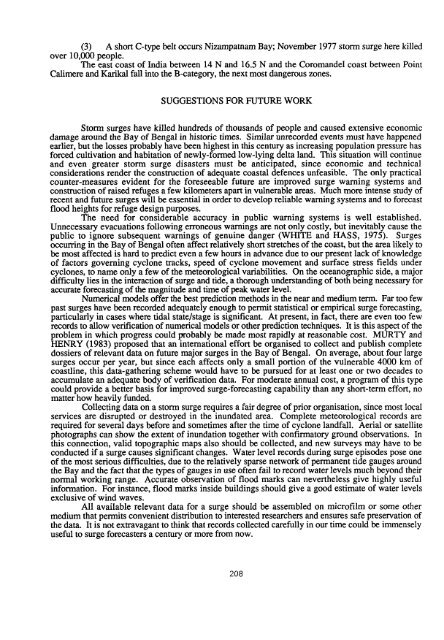139736eo.pdf (20MB) - Japan Oceanographic Data Center
139736eo.pdf (20MB) - Japan Oceanographic Data Center
139736eo.pdf (20MB) - Japan Oceanographic Data Center
- No tags were found...
You also want an ePaper? Increase the reach of your titles
YUMPU automatically turns print PDFs into web optimized ePapers that Google loves.
(3) A short C-type belt occurs Nizampatnam Bay; November 1977 storm surge here killedover 10,000 people.The east coast of India between 14 N and 16.5 N and the Coromandel coast between PointCalimere and Karikal fall into the B-category, the next most dangerous zones.SUGGESTIONS FOR FUTURE WORKStorm surges have killed hundreds of thousands of people and caused extensive economicdamage around the Bay of Bengal in historic times. Similar unrecorded events must have happenedearlier, but the losses probably have been highest in this century as increasing population pressure hasforced cultivation and habitation of newly-formed low-lying delta land. This situation will continueand even greater storm surge disasters must be anticipated, since economic and technicalconsiderations render the construction of adequate coastal defences unfeasible. The only practicalcounter-measures evident for the foreseeable future are improved surge warning systems andconstruction of raised refuges a few kilometers apart in vulnerable areas. Much more intense study ofrecent and future surges will be essential in order to develop reliable warning systems and to forecastflood heights for refuge design purposes.The need for considerable accuracy in public warning systems is well established.Unnecessary evacuations following erroneous warnings are not only costly, but inevitably cause thepublic to ignore subsequent warnings of genuine danger (WHITE and HASS, 1975). Surgesoccurring in the Bay of Bengal often affect relatively short stretches of the coast, but the area likely tobe most affected is hard to predict even a few hours in advance due to our present lack of knowledgeof factors governing cyclone tracks, speed of cyclone movement and surface stress fields undercyclones, to name only a few of the meteorological variabilities. On the oceanographic side, a majordifficulty lies in the interaction of surge and tide, a thorough understanding of both being necessary foraccurate forecasting of the magnitude and time of peak water level.Numerical models offer the best prediction methods in the near and medium term. Far too fewpast surges have been recorded adequately enough to permit statistical or empirical surge forecasting,particularly in cases where tidal statehtage is significant. At present, in fact, there are even too fewrecords to allow verification of numerical models or other prediction techniques. It is this aspect of theproblem in which progress could probably be made most rapidly at reasonable cost. MURTY andHENRY (1983) proposed that an international effort be organised to collect and publish completedossiers of relevant data on future major surges in the Bay of Bengal. O n average, about four largesurges occur per year, but since each affects only a small portion of the vulnerable 4000 km ofcoastline, this data-gathering scheme would have to be pursued for at least one or two decades toaccumulate an adequate body of verification data. For moderate annual cost, a program of this typecould provide a better basis for improved surge-forecasting capability than any short-term effort, nomatter how heavily funded.Collecting data on a storm surge requires a €air degree of prior organisation, since most Iocalservices are disrupted or destroyed in the inundated area. Complete meteorological records arerequired for several days before and sometimes after the time of cyclone landfall. Aerial or satellitephotographs can show the extent of inundation together with confirmatory ground observations. Inthis connection, valid topographic maps also should be collected, and new surveys may have to beconducted if a surge causes significant changes. Water level records during surge episodes pose oneof the most serious difficulties, due to the relatively sparse network of permanent tide gauges aroundthe Bay and the fact that the types of gauges in use often fail to record water levels much beyond theirnormal working range. Accurate observation of flood marks can nevertheless give highly usefulinformation. For instance, flood marks inside buildings should give a good estimate of water levelsexclusive of wind waves.All available relevant data for a surge should be assembled on microfilm or some othermedium that permits convenient distribution to interested researchers and ensures safe preservation ofthe data. It is not extravagant to think that records collected carefully in our time could be immenselyuseful to surge forecasters a century or more from now.208
















